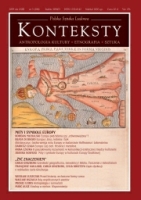Moda męska w XVI w. – obraz cnoty, rozumienie świata
Men’s Fashion in the Sixteenth Century – an Image of Virtue, an Understanding of the World
Author(s): Joanna Pietrzak-ThébaultSubject(s): Anthropology
Published by: Instytut Sztuki Polskiej Akademii Nauk
Keywords: anthropology; Europe; symbol; myth
Summary/Abstract: 'Eyes in the face of a man with studied proportions, a perfectly groomed beard, a prominent nose and a disclosed right ear. The juxtaposition of colours enables it to clearly contrast with the snow-white edge of a crimped collar (being extremely high it reaches the neck). We can see only this rim (a ruche, discreet in comparison with the opulence to come in the future), similarly to the gathered cuffs, while the rest of the shirt remains concealed. A black beret decorated with a flowing tinted feather prolongs the effect of colour achieved by the raven-black coiffure. Even if the hair does show first noticeable lighter tinges, it is still devoid of greyness'. With this description of a portrait entitled Cavalier in Black by Giovanni Battista Moroni, Amedeo Quondam, one of the leading contemporary Italian experts on sixteenth-century literature, began his book on the men’s 'black' fashion at the Italian and European courts of the sixteenth century – Tutti i colori del nero. Moda e cultura del gentiluomo nel Rinascimento (series Rinascimenti, Angelo Colla Editore, Costabissara /Vicenza/ 2007). Cavaliers, poets, princes and emperors dressed in black irrevocably replaced the colourfully attired courtiers of the previous generation – a turn of centuries and of epochs. Fashion cased being solely an expression of social status and became also a question of individual choice. In this ostensibly trivial phenomenon the author sought symptoms of profound cultural changes upon the threshold of Classicism. Quondam showed how much there is to define and comprehend of what he described as the 'new classical culture', as well as the need for a skill necessary to benefit from assorted thematic fields – starting with the history of art, material history, the history of editorship and the anthology of colour to literature and semantics. For the purpose of understanding these transformations he made use both of the avant-garde literature of the period, with the invaluable Il Libro del Cortegiano by Baldassare Castiglione, and extremely popular genres, today regarded as secondary: dialogues on the nature of love, treatises about the symbolic of colour, emblematic-heroic impresse, descriptions of court ceremonies, etc. In doing so, he penetrated changes of manner and morals, dealt with the technology of dying fabric and the production of paint, browsed through posthumous inventories, recalled the reconstructions of authentic costumes, resorted to semantic analyses and evoked the history of native and borrowed words. Upon numerous occasions he managed to topple statements repeated for years without any suitable verification, such as those about the origin of the 'black' fashion accepted on the Apennine Peninsula together with Spanish domination. The author linked facts that at first glance appear to be distant: the dates of the editions of particular writings, royal visits, imperial funerals … In assorted 'micro-signs' he discerned the power of explaining global phen
Journal: Konteksty
- Issue Year: 2009
- Issue No: 03
- Page Range: 128-135
- Page Count: 8
- Language: Polish
- Content File-PDF

